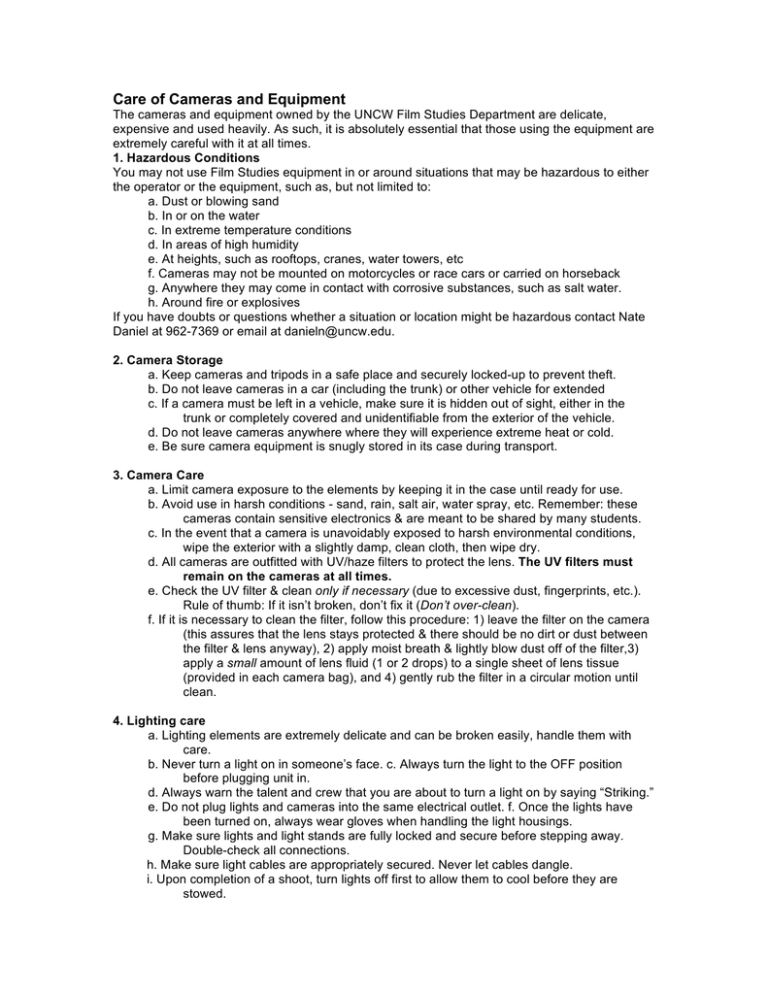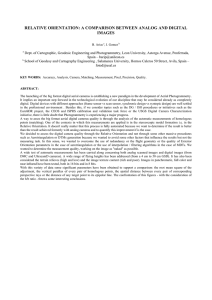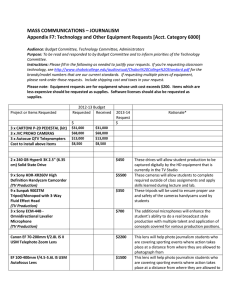Care of Cameras and Equipment
advertisement

Care of Cameras and Equipment The cameras and equipment owned by the UNCW Film Studies Department are delicate, expensive and used heavily. As such, it is absolutely essential that those using the equipment are extremely careful with it at all times. 1. Hazardous Conditions You may not use Film Studies equipment in or around situations that may be hazardous to either the operator or the equipment, such as, but not limited to: a. Dust or blowing sand b. In or on the water c. In extreme temperature conditions d. In areas of high humidity e. At heights, such as rooftops, cranes, water towers, etc f. Cameras may not be mounted on motorcycles or race cars or carried on horseback g. Anywhere they may come in contact with corrosive substances, such as salt water. h. Around fire or explosives If you have doubts or questions whether a situation or location might be hazardous contact Nate Daniel at 962-7369 or email at danieln@uncw.edu. 2. Camera Storage a. Keep cameras and tripods in a safe place and securely locked-up to prevent theft. b. Do not leave cameras in a car (including the trunk) or other vehicle for extended c. If a camera must be left in a vehicle, make sure it is hidden out of sight, either in the trunk or completely covered and unidentifiable from the exterior of the vehicle. d. Do not leave cameras anywhere where they will experience extreme heat or cold. e. Be sure camera equipment is snugly stored in its case during transport. 3. Camera Care a. Limit camera exposure to the elements by keeping it in the case until ready for use. b. Avoid use in harsh conditions - sand, rain, salt air, water spray, etc. Remember: these cameras contain sensitive electronics & are meant to be shared by many students. c. In the event that a camera is unavoidably exposed to harsh environmental conditions, wipe the exterior with a slightly damp, clean cloth, then wipe dry. d. All cameras are outfitted with UV/haze filters to protect the lens. The UV filters must remain on the cameras at all times. e. Check the UV filter & clean only if necessary (due to excessive dust, fingerprints, etc.). Rule of thumb: If it isn’t broken, don’t fix it (Don’t over-clean). f. If it is necessary to clean the filter, follow this procedure: 1) leave the filter on the camera (this assures that the lens stays protected & there should be no dirt or dust between the filter & lens anyway), 2) apply moist breath & lightly blow dust off of the filter,3) apply a small amount of lens fluid (1 or 2 drops) to a single sheet of lens tissue (provided in each camera bag), and 4) gently rub the filter in a circular motion until clean. 4. Lighting care a. Lighting elements are extremely delicate and can be broken easily, handle them with care. b. Never turn a light on in someone’s face. c. Always turn the light to the OFF position before plugging unit in. d. Always warn the talent and crew that you are about to turn a light on by saying “Striking.” e. Do not plug lights and cameras into the same electrical outlet. f. Once the lights have been turned on, always wear gloves when handling the light housings. g. Make sure lights and light stands are fully locked and secure before stepping away. Double-check all connections. h. Make sure light cables are appropriately secured. Never let cables dangle. i. Upon completion of a shoot, turn lights off first to allow them to cool before they are stowed. 4. Tripods a. If tripods are exposed to the elements (e.g., sand, rain), clean them off with a damp cloth then dry them immediately after use. b. If tripods are to be used in dirt or sand, cover the feet with plastic bags secured with gaff tape. c. Never set the tripod upright without spreading the legs (i.e. don’t lean the tripod against a wall or other surface). 5. Slates Use only Marks-A-Lot dry-erase markers on the slate. DO NOT USE PERMENANT MARKERS. Do not use china markers, pens, pencils or chalk. Do not use Sanford Expo markers – they will stain the board. Do not use ANY cleanser on the slate. Wipe with only a soft cloth.




